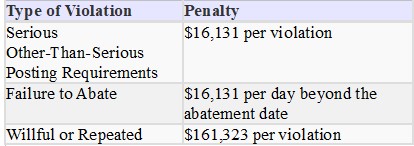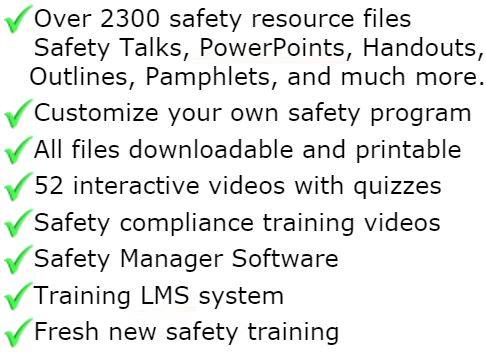
FORKLIFT BATTERY CHARGING SAFETY
This is a sample or partial document
Download the full customizable and printable version
Regardless of the type of electric material handling equipment you use, such as forklifts, pallet jacks, rider pallet jacks, walkie stackers, personnel carts or others, one thing is certain and that's battery charging.
In this program we want to emphasize that each equipment and battery manufacturer has its own specific maintenance and operating procedures and these should be followed at all times.
Your company has specific rules and procedures and these should also be followed.
The information in this program has been taken from a variety of sources, a variety of manufacturers and information used by many companies with excellent maintenance practices. It's a review of the basics of charging batteries, regardless of the type equipment used, however, it's up to each individual to follow your company's rules and procedures when charging batteries.
Ok, let's begin the program by reviewing some basic tips for handling industrial equipment batteries. The first rule is to always wear personal protective equipment, which includes rubber apron, gloves, boots and face/eye protection when handling, checking, filling, charging or repairing batteries. Electrolyte used in the batteries is a mixture of sulfuric acid and water and is quite caustic which can easily burn your skin.
Keep open flames away from batteries and never try to check the electrolyte level with a cigarette lighter or match. Use a non-sparking flashlight or other approved lighting and do not smoke or create sparks near batteries. The space between the underside of the cover and the top of the electrolyte in the cell usually contains a hydrogen-oxygen mixture which is explosive when ignited. Make sure you charge batteries only in those areas approved for battery charging and is well ventilated.
Be prepared for an electrolyte spill and have adequate water available to flush your skin or other affected area with water. Volumes of water applied quickly and continuously will prevent serious injury to the skin. Quick medical attention is necessary to assure proper care and treatment.
Splashes to the eyes can be avoided by wearing proper eye/face protection, however, if electrolyte is splashed into the eyes, wash the eyes with water for 15 minutes and get immediate medical attention. Spills should be cleaned up immediately by using a strong neutralizer such as baking soda. The baking soda will neutralize the acid and make it safe to clean or flush from the floor or other surfaces.
When changing or repairing plugs or receptacles that are connected to the charging equipment, be sure to shut off the power first. This will prevent a short circuit and arcing of an electrical spark. Arcing can cause an explosion and fire. When mixing acid to prepare electolyte, ALWAYS POUR THE ACID SLOWLY INTO WATER and never pour water into the acid. If water is added to acid it will not readily mix and will splash the acid due to the great difference in the specific gravity of the two liquids. Always store acid in plastic or glass containers. Always lift batteries with mechanical equipment such as a hoist, crane or lift truck. Move batteries horizontally with power trucks, conveyors or rollers. Make sure that hoist hooks, spreader bars and other tools are of ample strength and properly installed.
Cover the top of batteries with a rubber mat or other insulating material to prevent external short circuits from chains or cables falling onto the top of the battery. Proper handling of batteries is essential to prevent injuries and to prevent battery damage or electrolyte spills.
Make sure that charging plugs and receptacles are properly locked and all other connections tight, secure and free from friction. A loose connection may mean sparking or arcing near highly explosive gas mixtures. Enclose all bare wires and bus bars in the battery room by wire guards, guard rails or other means of isolation from general plant traffic, as any open, high current transmission equipment is a possible hazard to you, other workers and the equipment.
Double check to make sure the charger being used matches the voltage and amperage of the equipment battery. Voltages and amperages are found on the equipment data plate and on the charger data plate. Before disconnecting or connecting batteries to a charger, make sure the charger is in the OFF position. If an attempt is made to do this while the charger is ON, serious injury to you, the battery and charger could result. Before charging, make sure the battery cells contain the correct amount of water. Charging batteries with a low water level might result in damage to the cells. Keep in mind that battery fumes are explosive and to check the cells with a flashlight or other approved light. Before connecting the battery cable to the equipment's receptacle, make sure the key switch is off and all controls are in the off position and the brakes are locked. The battery cable must be fully connected before the equipment is used. If the plug is not making good contact, heat will weld the two parts of the battery connector together, making it difficult to remove and necessary to replace. Battery terminals should be checked and cleaned of any corrosion.
Good battery terminal contact is essential not only for operation, but also for proper charging of the battery. The battery cover should be closed except when charging, then it must be left open. Disconnect the battery from the truck when doing maintenance and repair work on the motor or electrical system.
Obviously, live current may cause arcing or short circuiting. Never lay metal tools such as wrenches or other material on top of an open battery. Sparking and short circuiting will occur and can quickly discharge the battery or may explode. Check batteries for cracks or leaks and repair them when detected. If batteries are not in use, they should be kept charged. A freshening charge of about 3 to 4 hours at the finish rate may be necessary if the specific gravities have fallen 30 points or more.
When recharging a fully discharged battery, the starting charge rate may be 3 to 5 times higher than the finish charge rate indicated on the battery nameplate. The charge rate should taper down to the finish charge rate by the time the battery is 85 percent charged and may be even lower when fully charged. High "on charge" temperatures or frequent need to add water are indications of overcharging.
Be sure to follow the equipment manufacturer's instructions on proper battery charging. The top of the battery should be kept clean and dry. Keep vent caps in place during use and when charging. Let's stop here a minute because there have been questions and confusion in the past about the practice of leaving vent caps on or off during charging. Many years ago, safety rules dictated that vent caps must be left off during charging, to help dissipate the heat during charging. However, in the past 15 or so years, engineers and other safety professionals have determined that vent caps must remain on during charging.
Most manufacturers today also state that vent caps should remain on during charging. Vent caps must be checked to make sure the vent holes are not plugged and are functioning properly. The vent caps dissipate heat during charging and allow small volumes of gas mixtures to escape. If the vent caps are left off, a large volume of hydrogen gas could escape and build up, creating a greater explosive hazard. It is clear however, that battery compartment covers must remain open during charging.
When batteries are not mounted on equipment, they should be placed in proper storage areas, but never stored directly on a cement floor. If necessary, place them on wooden pallets and store in a dry, moderately cool area. Lead acid batteries will slowly "self discharge" over a period of time due their chemical makeup. If the self-charge is left uncontrolled, excessive sulfation can occur which is difficult to reduce and may damage the plates.
If a greasy film forms on the top of batteries, this is acid and should be neutralized with a baking soda solution. Keep all batteries in a clean condition. Have we left anything out?
How about the type of water you should use when filling the battery? The answer is to always use distilled water. The reason for this is simple. Distilled water removes impurities in water. Using regular tap water in batteries causes these impurities to attach themselves to the battery plates during charging, or chemical action and can cause the battery to decrease it's normal life expectancy. Use distilled or other approved water when filling batteries. Don't use tap water because it will cause the life of the battery to be decreased over time. Always follow your equipment manufacturer's recommendations. Some manufacturers recommend that when your battery is discharged 85 percent, it's time to get it recharged.
Some manufacturers don't have charge/discharge meters on their equipment. The moral of the story is to follow the manufacturer's recommendations.
Equipment, battery and charger manufacturer's instructions, combined with your company's policies and procedures are the best sources of information for safety and long life of the equipment. If you're not sure about something, ask your supervisor. The job and the equipment you use is too important to be left to chances.

GET INSTANT ACCESS
to THE MEMBERS LIBRARY
Safety materials created by safety professionals.
Access to the Safety Manager software.
Wide variety of safety videos and courses.
**Brand New** Safety Training Management System
Pre-Made Safety Materials Ready For Use
Created by experienced safety professionals & risk consultants. Saving you time, money, and risk of injuries.
95% of the work already done.
Below are the maximum penalty amounts, with the annual adjustment for inflation, that may be assessed after Jan. 15, 2024. (See OSHA Memo, Jan. 8, 2024).

**New OSHA HEAT 90 DAY**
>>Download Free HERE<<
**New 2024 OSHA 300 Form**
>>Download Free HERE<<
**Brand New**
Free with full membership subscription
Training LMS System
Ask The Safety Consultant
Safety Equipment Deal Finder

“SafetyInfo.com is the first go-to website for safety professionals and companies to use in establishing a solid safety program"
-Mike McKenzie, Certified Safety & Health Manager (CSHM), McSafety Solutions™
Note: You must have a full subscription to the Safety Library in order to use this material. Any use outside of your organization, for resell, or without an active membership is strictly prohibited and may result in prosecution under copyright infringement laws. Please contact us first, if you would be interested in reselling or using our materials for reproduction.
Inside the Members Library
Topic Index
Accident Prevention
Air Quality
Asbestos
Bloodborne Pathogens
Boilers
Chemical Safety
Compressed Gas
Confined Space
Construction
Construction Worksite
Cranes & Slings
Driver / Fleet Safety
Drug Free Workplace
Electrical
Emergency Management
Engineering Safety
Environmental
Equipment
Ergonomics
Fall Protection
Fire Safety & Prevention
First Aid
Flammable Materials
Forklifts
Hazard Communication
Hazardous Materials
Hearing Protection
Heat Stress
Hot Work
Housekeeping
Job Safety Analysis
Laboratory
Ladders
Lead
Lockout-Tagout
Machinery & Equipment
Material Handling
MSDS (SDS)
Medical & First Aid
Occupational Health
Office Safety
Off the Job Safety
Personal Protection
Process Safety
Record Keeping
Respiratory Protection
Silica Safety
Rules & Policies
Signs & Labels
Slips, Trips & Fall
Training
Terrorism Programs
Tool Safety
Vehicle & Driver
Violence Programs
Welding & Hot Work
Training Videos
Library Index
Training Materials
Videos/Courses
Talks
Articles
PowerPoint
Handouts
Training Overheads
Quizzes
Supervisor Briefs
Management Briefs
Safety Sessions
2 Minute OSHA Safety Talks
Pamphlets
First Aid Training
Supervisor Training
Hazardous Materials
Bomb Threat
Crossword Puzzles
Biological Agents
Forms & Documents
Forms
Checklists
Audit Guides
Inspections Guides
Signs & Labels
Environmental Audit Guides
Recordkeeping - OSHA 300
Sign & Label Maker
Safety Management Resources
Safety Manuals/Written Programs
Ergonomic Programs
Emergency Plans
Process Safety Management
Construction Safety
Occupational Health
Environmental
Topic Sheets
DOT Fleet-Driver
Hazardous Materials
Chemical Safety
Drug Free Workplace
Terrorism Programs
Development Guides
Safety Manager Software
Safety References & Graphics
Technical Safety Information
Posters
Topic & Fact Sheets
Development Information
Job Specific Safety Rules
Terrorism
Calculators
Safety Comic Strips
New Safety Training System
Schedule and train your employees with our materials. Add unlimited amount of employees. Record all progress and issue certificates. For group and individual training sessions.

